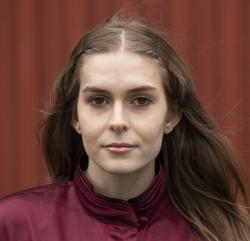I ventured out from the cosy and often too comfortable 101 bubble to meet with Sigurþór Hallbjörnsson—better known as Spessi—in Reykjavík’s Breiðholt neighbourhood, postal code 111. An acclaimed Icelandic photographer and founding member and chairman of the Icelandic Contemporary Photography Association, Spessi is known for his dozens of album covers as well as his unusual photography projects, most notably his book ‘Bensín,’ for which he photographed gas stations around Iceland.

The photos in his new book, ‘111’, were taken in the towering buildings surrounding the site of the exhibition, RÝMD — a former bakery in a one-story building with a beautifully antiquated and uneven tile floor, and so many cracks in the wall that they could be seen through the fresh white paint. The entrance to the gallery is in a busy alleyway, where buff-wearing children, snail-paced elderly folks, and nike-clad teenagers go about their daily lives.

Walks of life
‘111’ is a photographic portrait of the neighbourhood and people of Breiðholt. His portraits feature people from many different walks of life. Spessi feels a certain familiarity in Breiðholt. “There is a Breiðholt everywhere in the world,” he said. Breiðholt is unlike any other neighbourhood or community in Iceland—Many Icelanders refer to Breiðholt as ‘the only Icelandic ghetto’—and Spessi has chosen to shatter the commonly held prejudices that have come to exist about the neighbourhood and its people.

Identity and pride
Spessi’s photographic projects focus on subcultures, which is why he chose to photograph 111, and the people who live there. He found that it was important to photograph the people of Breiðholt in order to properly represent them. “A lot of people who live here tattoo 111 on their chest.” he explains “It’s this kind of identity. It’s more like a state of mind, this postcode. It’s like ‘I’m from the hood’—this kind of pride.”

Breiðholt was a social housing project planned and designed in the 70s and eventually built in the 80s. The idea was to build brightly-coloured apartment buildings with surrounding alleys, children’s playgrounds, and football fields so that children wouldn’t have to cross busy streets to go to school in the morning.

Breiðholt was well intentioned, but it didn’t age well when its population rose and the city developed more. “It was a good thought in the beginning, but it was a mistake,” Spessi sighs. Breiðholt eventually became crowded, and resulted in both the physical and social isolation of the people who lived there. “So actually, this is wrong, it’s a disease in the society.”
Spessi’s people
Spessi has a personal affinity and appreciation for the people of Breiðholt, because he relates to them in a lot of ways. “I’m so used to these people,” he says. “I’ve been around. I was a drug addict, a drunk, and I’ve been through a lot of things. So for me to come to a crack party—I’ve been there. I grew up with my grandparents, and they were very poor. These are my people, and that’s why I wanted to show the world how it is.”

He explained to me the challenges he encountered in pursuing this project during the past two years and the difficulties in deciding how to appropriately approach this project. “This is a very political show,” Spessi stresses. “I’m not showing these people as victims.” His intention with this project is instead to portray these people and their spaces in an empowering way—in a way that authentically and accurately represents them and their spaces, on their own terms.

A story of survival
“When you enter someone’s intimate space, that’s a very interesting spot, because then you feel something,” Spessi says. “Sometimes you feel that they are afraid, that they don’t trust you, or there’s a language problem, so they don’t understand what you’re saying, so there are all kinds of things that happen when you come into this [space]. When I take portraits of those people I try to let them choose how they present themselves. That’s why most of my photos are kind of objective.”

His portraits evoke a lot of emotion and different reactions from those who view them. It is clear that the point of the images isn’t to create a feeling of melancholy or sadness. Some of the faces look lonely, or scared—but they still want to be seen. This isn’t made out of pity, but rather, out of pride. It is ultimately a story of survival in the challenging realities of the everyday.
111 is being exhibited at RÝMD at Völvufell 13 through June 17th, as a joint effort between the Reykjavík Listahátíð, and the Breiðholt Festival.
Buy subscriptions, t-shirts and more from our shop right here!
















